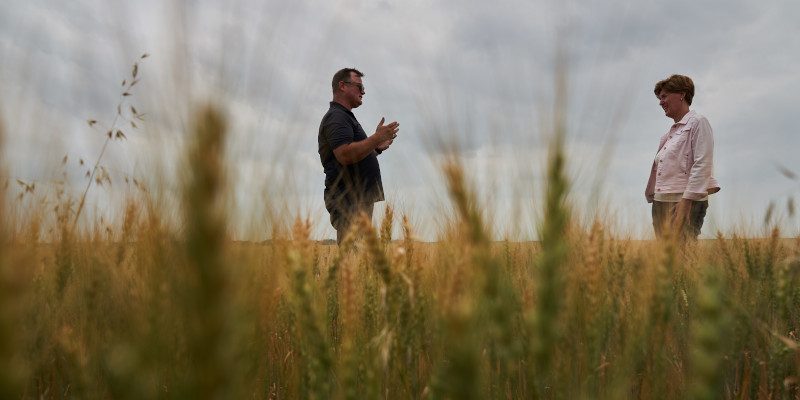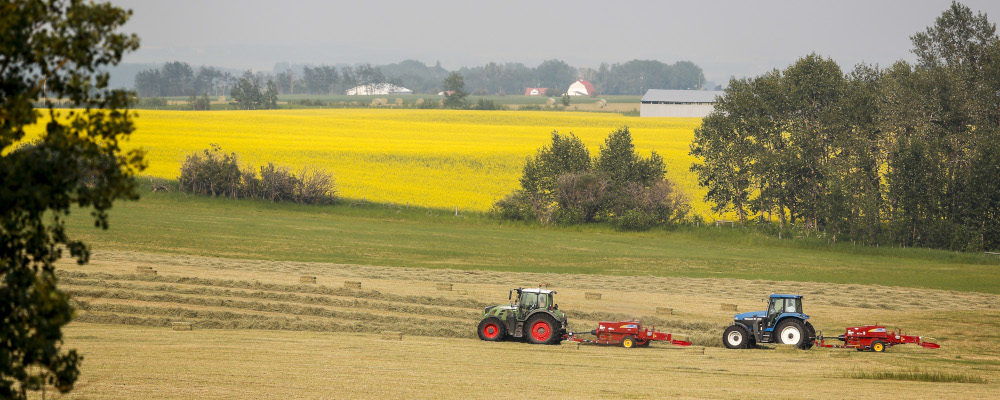Extreme weather exacerbated by climate change is wreaking havoc across Canada this summer.
The heat dome along the West Coast and forest fires are having devastating consequences. While it may not always make the headlines, extreme weather is also creating chaos for farmers and Canada’s food system this summer. Unfortunately, this severe weather is the new normal for Canada’s farmers and it is time that farmers and governments become better prepared.
The risks and impacts of extreme weather are real and are being felt now. As early as the beginning of June, farmers warned of drought risk, saying that feed supplies could dry up as early as July. Those early warnings were right. Farmers have been looking for feed, but it is expensive and far away, if they can find it. As a result, many have been forced to shrink their herd size, sending animals to market. Market watchers are already reporting an increase in cattle going to auction and expect volumes to increase.
MORE SIGNAL. LESS NOISE. THE HUB NEWSLETTER.
Grain farmers are watching prices go up as grain supplies decrease. Higher prices help grain producers mitigate lower yields, but some farmers are struggling to grow enough to fill existing contracts, let alone take advantage of the higher prices. In addition, not filling a contract can force a farmer into paying a penalty to the grain company or trader they have a contract with. This adds stress to an already difficult situation.
The impacts of extreme weather highlight the comprehensive way climate change is driving Canadian agriculture and food.
Recently, agriculture’s role as a source of climate change solutions has been a major focus. Efforts made over the last 30 years as farmers have moved to conservation tillage practices, adopted better plant and animal genetics, diversified crops, improved feed efficiencies and lowered input use have increased soil organic carbon, improved water retention and reduced the overall environmental footprint of agriculture. Farmers can and are doing more as our understanding of agriculture’s role in greenhouse gas mitigation and carbon sequestration increases.
Due largely to farmers changing the way they farm, in 2000, Canadian soils sequestered more carbon than they emitted. Current science estimates that Canadian soils will be able to accumulate additional carbon until at least 2040. Governments are catching up to the work that farmers are doing, with Canada’s climate plan and the 2021 federal budget committing almost $400 million to the sector with a mix of new and existing funding, to accelerate emissions reductions, boost carbon sequestration and adapt to climate change.
Farmers as climate change solution providers is only one side of the equation. Farmers are also on the front lines of a changing climate, struggling to adapt to changing weather and changing ecosystems. Around the world, food-producing regions are being impacted by climate change, with Canada being one of the few countries where agricultural frontiers are expanding. This means Canadian food producers are well placed to sustainably intensify food production and meet the critical challenge of feeding the world without destroying it.
However, as agricultural land changes, so too does the weather, and the weather is changing in extreme ways.
The increasing impacts of extreme weather should come as no surprise to farmers and governments. Last year a report from Natural Resources Canada said that on the Prairies “the impacts of flooding, drought and wildfire in recent years are unprecedented, and climate models suggest an increased risk of these events in the future.” In 2019, Agriculture and Agri-Food Canada launched a series of extreme weather indices “to help producers prepare for extreme weather conditions.”
The reality is that farmers are struggling now, and they need governments to act quickly.
In 2008 a Natural Resources Canada report cited research from 2003 confirming that rising temperatures would exacerbate drought conditions on the Prairies in the future. That same report highlighted some of the ways governments were responding to drought and its impact on farmers.
The report came just ahead of several years of extreme weather on the Prairies and across Canada. Prairie farmers faced a significant drought in 2009 and a substantial flood in 2010, triggering hundreds of millions of dollars in aid from governments.
Despite the science and the weather events, and the work by governments, farmers, businesses, and civil society, there is appears to be no concerted effort to develop a comprehensive strategy to mitigate, adapt and de-risk extreme weather.
At a recent CAPI event, Cornell Professor Christopher Barrett presented the need for socio-technical bundles to build sustainable, equitable, inclusive food value chains. This approach can guide Canada’s agri-food system as it strives to de-risk extreme weather.
A crucial part of a bundle must be increased research and knowledge transfer investments that advance our understanding of how to farm more resiliently. The Agriculture and Agri-Food Canada Living Laboratories Initiative is a step in the right direction, and the recent commitment of $185 million over 10 years will help farmers and scientists work together to do more.
Technology and innovation must also play a major role in insulating Canada’s food system from the risks of extreme weather. For example, new breeding tools, including gene-editing, are making it easier to develop drought-tolerant crops that are core to a more resilient food system. Developing new crops is challenging, but navigating Canada’s regulatory framework can make getting these tools into the hands of farmers even more difficult. Therefore, a bundle to de-risk extreme weather should include a modern regulatory framework that allows for technology and innovation to increase resiliency.
New risk management tools are also being developed to help farmers manage the financial impacts of extreme weather. For example, parametric insurance products are coming to market offering farmers insurance designed to address the changing weather. Bundling policies that encourage the development of these innovative risk management tools will help farmers de-risk weather.

However, the bundle should also include a backstop that kicks in when the impacts of extreme weather become more than a farmer can handle. The current Federal-Provincial-Territorial (FPT) program, AgriRecovery, isn’t a program but a “framework” used by governments when natural disasters occur.
In theory, governments should use the framework to work together, however recent announcements seem to point to that not happening.
This framework approach does not offer the timely, predictable, meaningful support farmers need in the face of extreme weather. The competing announcements from governments do little to address the uncertainty over whether a farmer will receive disaster assistance when they need it. An extreme weather policy bundle should include a new approach to disaster assistance.
The U.S. department of agriculture maintains a series of standing programs that farmers can access when their county is designated as a federal disaster area. While a process is still required, those processes have been streamlined, including a near-automatic designation when a county meets a severe drought intensity for eight consecutive weeks. The process provides certainty, both in what is required to be designated a disaster and in the aid that is available once that designation is made.
Earlier this year FPT Agriculture Ministers launched negotiations for their next five-year agreement. CAPI recently released a report exploring the background context to those agreements and calling for a more nimble approach that can better respond to the evolving risks that farmers face. Extreme weather is one of those risks that requires such an approach.
The negotiations provide a good opportunity for governments to partner with farmers and players across the food system to develop a comprehensive strategy, including research, regulatory reform, and a better disaster program to de-risk extreme weather.
The reality is that farmers are struggling now, and they need governments to act quickly. The AgriRecovery announcements alongside tweaks to existing programs are steps in the right direction. However they are not the long term plan that farmers, governments and the rest of the agri-food system need. The new extreme weather normal may already be here, but it is not too late to prepare for future weather disasters.




